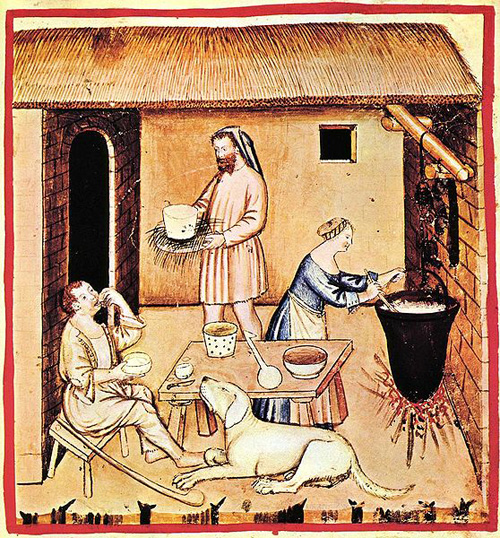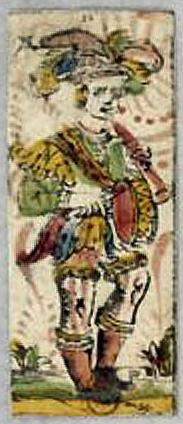While the PMB Bagatto is reaching for a straw hat the significance of that gesture cannot be “sleight of hand” nor “entertaining” when there is no audience. The next oldest bagatto, again, the EE, where the standard street performer has been mapped over the original PMB Bagatto and thereby inflected its meaning, retained in later decks.
So let’s move on to the specific attributes of the PMB Bagatto:
1. Four objects lie near or in the left hand of the Bagatto: a knife, 2 coins, a glass cup, and scepter, held almost like a stylus to the table. A case for the latter day conceit that the objects before the bagatto represent the four suits can actually be made here. However, the scepter is singled out as the one being held…
2. The scepter is identical to the scepters held by several of the court cards and trumps with the notable difference that only the Bagatto holds his a sinistra.
3. With his opposite right hand the bagatto does not hold but rather reaches for a straw hat. A straw hat could be worn by nobility (such as one finds in in the central figure in the month of May in the Les Très Riches Heures du duc de Berry (c. 1416) but it was much more common as natural colored or white on the peasantry, such as one finds in the month of July in the same work (http://en.wikipedia.org/wiki/File:Les_T ... uillet.jpg). The rumpled hat here clearly indicates a peasant’s hat and, agreeing with the premise that the Fool and Bagatto form a pair, should thus mean that the hat belongs to the Fool.
4. Most interesting is the large unusual hat on the Bagatto himself, which - to my understanding - has not been identified before. In fact it is the same hat worn by the surviving suit of coin court cards of the Brambilla deck, although rather shabby by comparison (its ends droop) in the PMB Bagatto:


My interpretation is based on the internal evidence of the card and in the context of the Visconti-Sforza decks: this Bagatto is indeed committing an act of fraud – sedition to put it more clearly – by reaching for control of the popolo (signified by the Fool’s hat). This was an utmost concern to the newly installed Sforza regime following the Ambrosian Republic, run at the end by common people (notably a weaver and notary) who carried out murderous proscriptions of Milanese nobility (e.g., Filelfo Ode I.10.89f). Put in this light the PMB deck is in fact related to the genre of a Mirror of Princes (e.g., John of Salisbury’s Policraticus), with this card being a cautionary tale; the Hanged Man the rememedy for such persons.
The relevant documents produced by Vitali showing the Bagatto as one who employs a web of stratagems, not simple parlour tricks, are the earliest ones.
In the Morgante of Pulci (1432-1484) are two examples of 'fraudulent action, cunning, deceit': … and, still with reference to Gano: "Think, Reader, if the traitor[u/] [my emphasis] put in order / All his bagatelle and lies, / And his mandrakes (poison) and snakes (envy) and dice-shakers (deceptions) / And showed his dust and bags and tricks / And showed them to all..." (11) (Text 4)
We have a similar meaning in the Novellino of Masuccio Salernitano (of Salerno) (c. 1410-1475) (Novella XX), where a gentleman of Salerno, madly in love with a widow, was finally punished, he who "never was punished for any of those tricks and bagatelle that he had all employed all his life" (12). (Text 5).
Continuing, so Macchiavelli (1469-1527) in Clizia, where Nicomachus, an old man, in love with Clizia, responds to Sophronia (Act II - Scene III):
Nicomachus: You threaten me with your chatter; don’t make me say it. Do you think perhaps that I am blind and I do not know the games (the plots) of these your bagatelle? I indeed knew that mothers cared for their children, but I did not think they wanted to support their children in their dishonest actions” (Text 6)
Most germane to the PMB Bagatto’s aristocratic airs put on via his dress is this quote from Vasari:
Vasari (1511-1574), referring to Giovannantonio, the painter called "The Sodom of Verzelli", also Mattaccio, says of him: "But he always had the spirit of foolishness and worked at his whim, caring for nothing more than dressing pompously, wearing doublets of brocade, cloaks all ornamented with gold cloth, the richest caps, necklaces, and other similar bagatelle and things of buffoons [buffoni] and charlatans [ciarlatani]" (7) (Text 1)
That one who actively engages in intrigue – whether for love or political gain (often the two were the same) – could be lumped in with the buffoni e ciarlatani, and thus fall under the general rubric of bagatelle, is clear from Vitali’s study. It is also clear as tarot developed, particularly for the mass market, that the Bagatto figure naturally tended towards the simpler figure of the conjuror, but the PMB Bagatto is quite simply not a conjuor of the street perfomer sort. By wearing the garb of his aristocratic betters and literally reaching out to control the common man he is overtly a political allegory in the PMB deck. Yet Hurst would have us believe this is an impossibility:
[T]he trump cycle is a moral allegory rather than an occult manifesto, political propaganda, rites of initiation to a secret society, etc. note 1 from his February 20, 2013 blog post: http://pre-gebelin.blogspot.com/
I do indeed see the PMB deck as manifestly political propaganda and not just the attributes of its Bagatto show this but the Fool as well. The PMB Fool has long since held to hold a club over his shoulder in accordance with its primary model, Giotto’s “Foolishness” in the Scrovegni Chapel; Giotto in turn borrowed that motif from the God-denying Fool medieval manuscript tradition in which a Fool often brandishes a club mindlessly upwards towards God, sometimes with David present as it is based on Psalm 52 (see V.A. Kolve, Telling images: Chaucer and the imagery of narrative II, 2009: 223f). A Milanese parallel: The peasantry in the exact same threadbare dress as the Fool but holding such a curved or gnarled club is also seen in the first illuminated copies of the Tacuinum Sanitatis commissioned by Giangaleazzo Visconti:

But the object slung over the Fool’s shoulder is perfectly straight, unlike a peasant’s club, until it flares out at the very end…like a trumpet. Look at the Berry Hour’s month of May previously referenced – a trumpeter on the far left wearing a straw hat leads the nobles, the long trumpet slung over his shoulder: http://upload.wikimedia.org/wikipedia/c ... roject.jpg
I could reproduce countless examples of such trumpters carrying their trumpets in this way (see Mantegna’s famous Triumph of Ceasar cycle for a famous one: http://en.wikipedia.org/wiki/File:Trium ... icians.jpg), but why when its much easier to just point to the Bologna deck – the closest in form to the ur-deck per Ross – which retained the Fool with trumpet down to the present day (a 17th century exemplar):

The significance? Trumpters are always shown announcing nobility and wear the nobles’ livery (e.g., the Berry example with the colors attached to the trumpet itself or the manuscript illumination showing Sforza and Bianca getting married beneath a phalanx of crossed trumpets). The PMB Fool-as-peasant – whether rural or lumpenproletariat (to use an anachronistic Marxist term) - without livery is categorically a rebel outside of aristocratic circles or rabble with pretensions to be wary of. The Bagatto and Fool are a pair in representing the Ambrosian Republic (the Artisan class directing the masses) – the one thing Sforza could not have Milan revert to. That the Ambrosian Republic lost its meaning even for Milan and the Sforza Dynasty meant these cards were bound to evolve to a more generic appearance.
That tarot has moral allegories within its sequence does not define its overall intent as a moral allegory per se, at least not the PMB. That a moralizing tendency was foisted onto tarot is clear by the many missing Devil trumps and the conversion of the papess as when the Bolognese card makers replaced the Papess (High Priestess), Pope (Hierophant), Empress, and Emperor with four Moors or Turks or in Minchiate, the first of the two Emperors are assigned number III because of the removal of the Papess (High Priestess) from the decks. The last third of Vitali’s essay is taken up with this very theme of church moralizing, particualry the meaning of ‘Bagatto’, turning it into virtual sin. That sedition is a ‘sin’, Sforza would accede to, but we have lost the original meaning of the card by looking at the Fool as the original God-denying Fool or simply as a sinner. That the aristocracy saw themselves as aligned with God’s directives does not mean that they were also not keen observers of the political condition well before Machiavelli put quill to parchment. The PMB is a post-Ambrosian Republic species of political propaganda, a card version of a Mirror for Princes: virtues to emulate, forces to be dealt with (Fortune, “star”/sun/moon = astrology), and an artisan class and peasantry to control – the Bagatto and Fool. Finally, it is worth mentioning that besides the condottieri Malatesta and Sforza, the first recipients of tarot are Ferrarese princes.
Phaeded
